Sculpting Serenity: Gandhara’s Indo-Greek Buddhist Art
The ancient region of Gandhara, the “Land of Fragrance,” played a vital role in developing Buddhist art and deepening its global...
Maya M. Tola 18 July 2024
Red porphyry is a rare dense stone from a remote quarry in the Egyptian desert. It bears a striking red and purple hue that commanded great interest throughout history, most prominently during the imperial period in Rome. The stone became a symbol of luxury and power throughout the long history of this region.
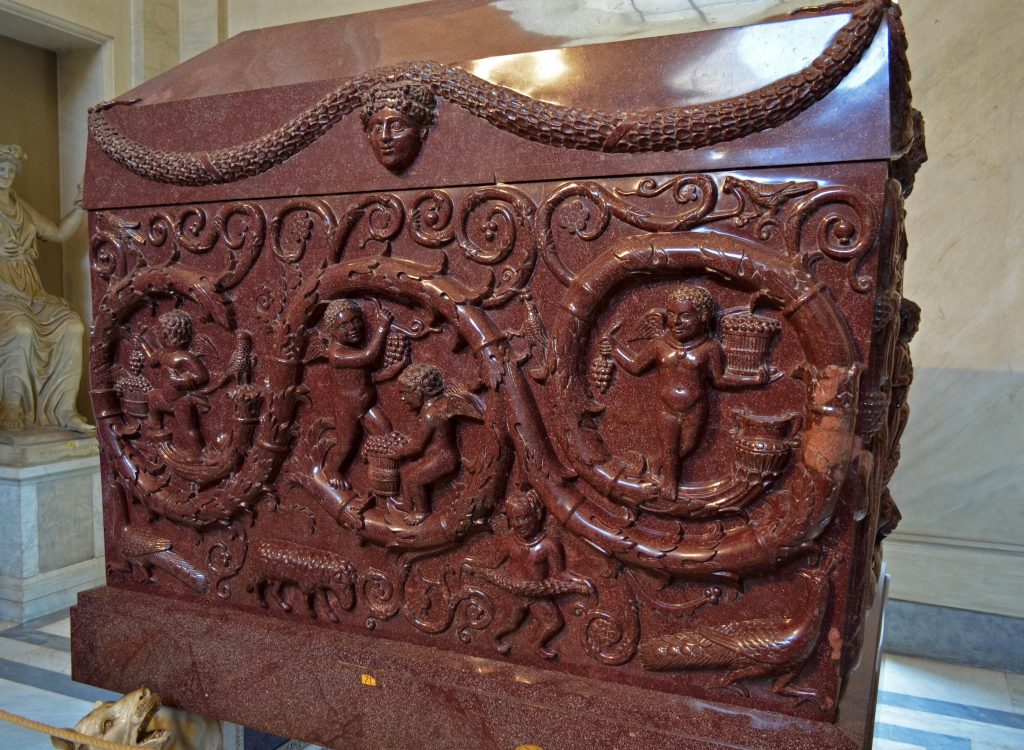
Red porphyry Sarcophagus of Helena, Musei Vaticani, Vatican City, Vatican.
The term “porphyry” originates from Ancient Greek, describing the rich purple color of the stone. It is an igneous rock known for its large, distinct crystals within a fine-grained matrix, distinct from the coarser matrix of granite. The presence of phenocrysts containing reddish-brown to violet minerals gives rise to its iconic red and purple hues. While “porphyry” has become a generic term for rocks with large spots or crystals, the purple variety from the Mons Porphyrites region is known as red porphyry, purple porphyry, or imperial porphyry. The extreme scarcity of red porphyry significantly contributed to its immense value, further enhancing its overall allure.
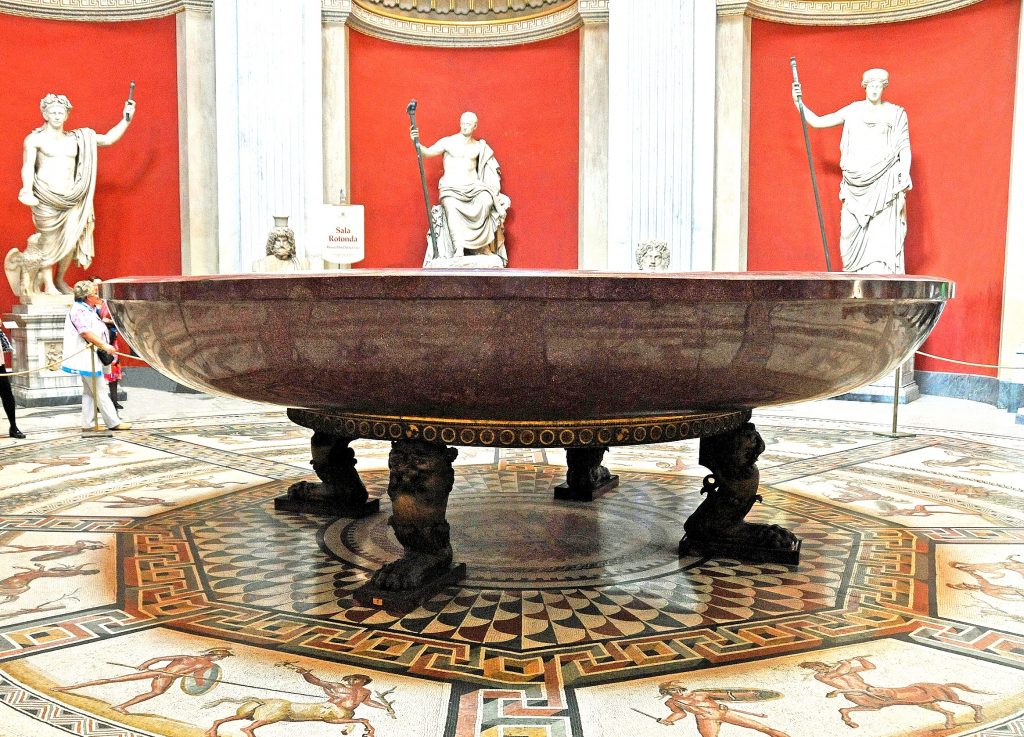
Nero’s bathtub in red porphyry, Musei Vaticani, Vatican City, Vatican. Photograph by Rudolphous via Wikimedia Commons (CC-BY-SA-2.0).
First exploited by the Egyptians around 1500 BCE, the primary source of this valuable stone was the ancient Mons Porphyrites. This remote quarry was situated in the Eastern Desert of Egypt, specifically within the mountain Jebel Dhokan. Quarrying activities at Mons Porphyrites persisted until around 500 BCE, producing substantial blocks of this distinctive material. After the Fall of Rome, the exact location of the quarry in Egypt was lost and remained undiscovered until 1823.
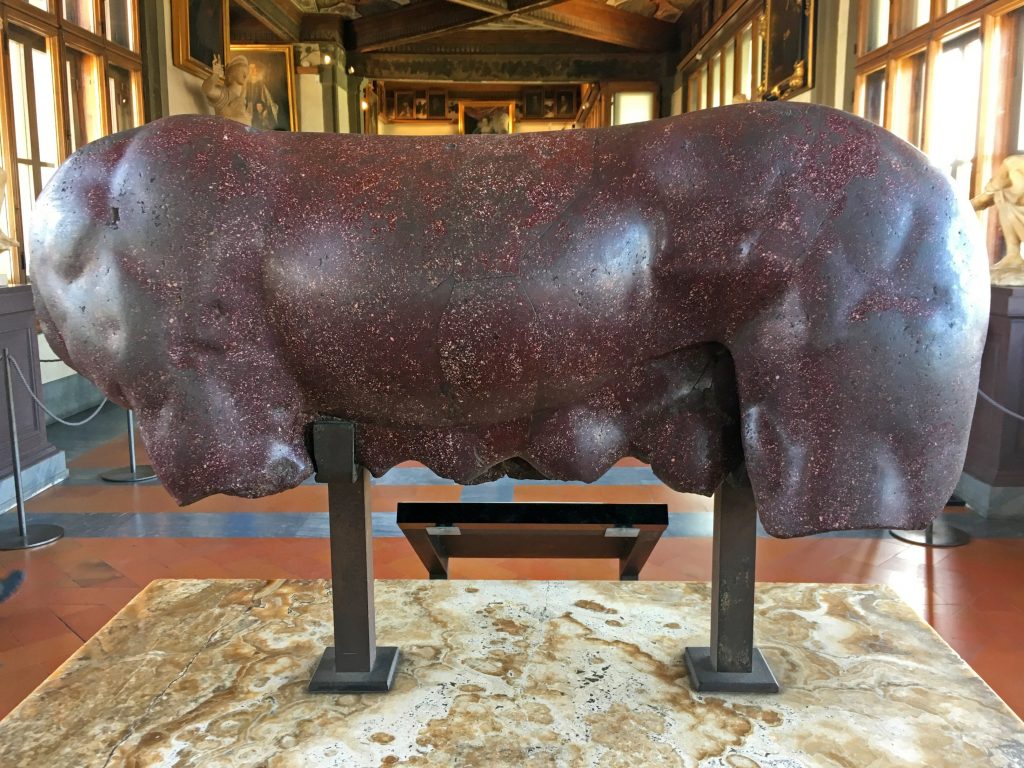
Remains of in ‘Lupa’ (She Wolf) in red porphyry, Uffizi Gallery, Florence, Italy. Photograph by Gareth Harney (@OptimoPrincipi on X), April 2020.
Porphyry’s history dates back to ancient times when it found use in both architectural and purely decorative elements. This exceptionally hard, dense, and heavy stone was transported by river and sea to various parts of the ancient world. The extraction and transportation of these hefty stone blocks represented monumental undertakings, emphasizing the immense value attributed to red porphyry by ancient civilizations.
In order to meet demand, the Romans extensively exploited the quarries, employing thousands of workers. They also had to transport it by ship from Egypt to other regions. Furthermore, they used specialized tools including solid, likely Roman, steel to cut the stone.
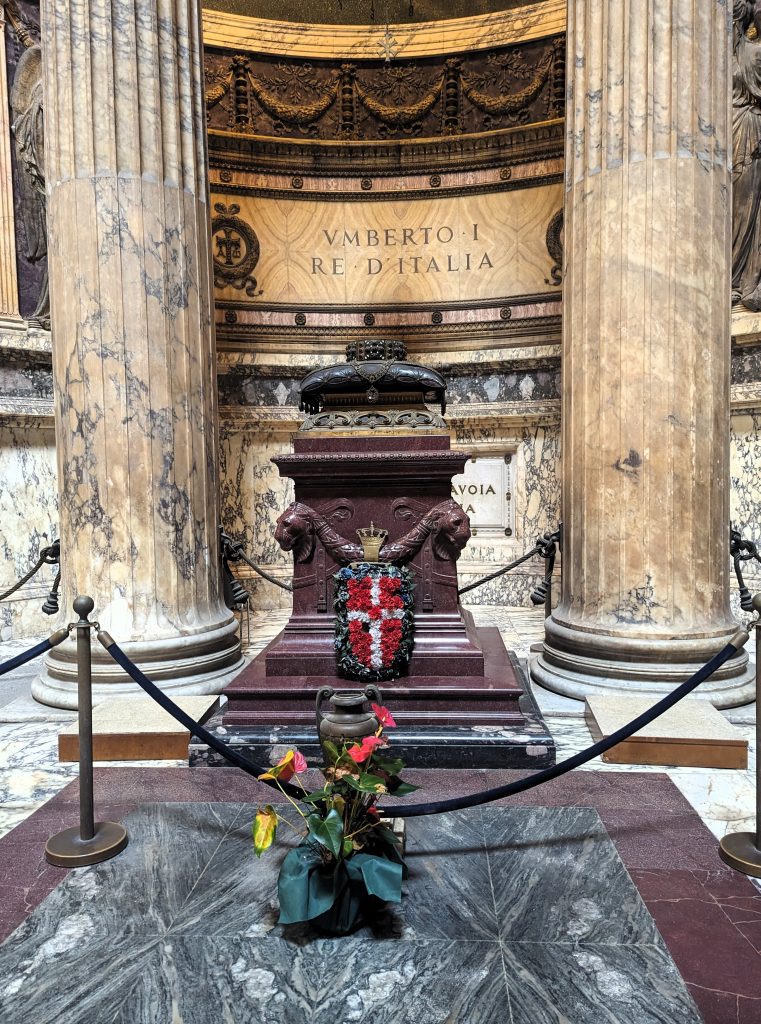
Sarcophagus in red porphyry at the Pantheon, Rome, Italy. Photograph by the author (September 2023).
Red porphyry boasts a rich history of use in Egyptian construction and architecture. The ancient Egyptians prized it highly for various projects, including temples, tombs, and monuments. However, its most significant use occurred during the imperial period in Rome, where it held a special place of favor among Roman royalty. The hue of the stone closely resembles the purple of the dye derived from shellfish, a hue adorning the garments of the Senatorial class.
Red porphyry thus became synonymous with imperial power, adorning the rooms of emperors’ palaces and even serving as the material for their sarcophagi.
Roman emperors imported red porphyry to use it in tiled floors, colored columns, vases, and of course, busts and sculptures. This stone played a pivotal role in the creation of magnificent works of art and architecture, underlining its significance in Roman building projects.
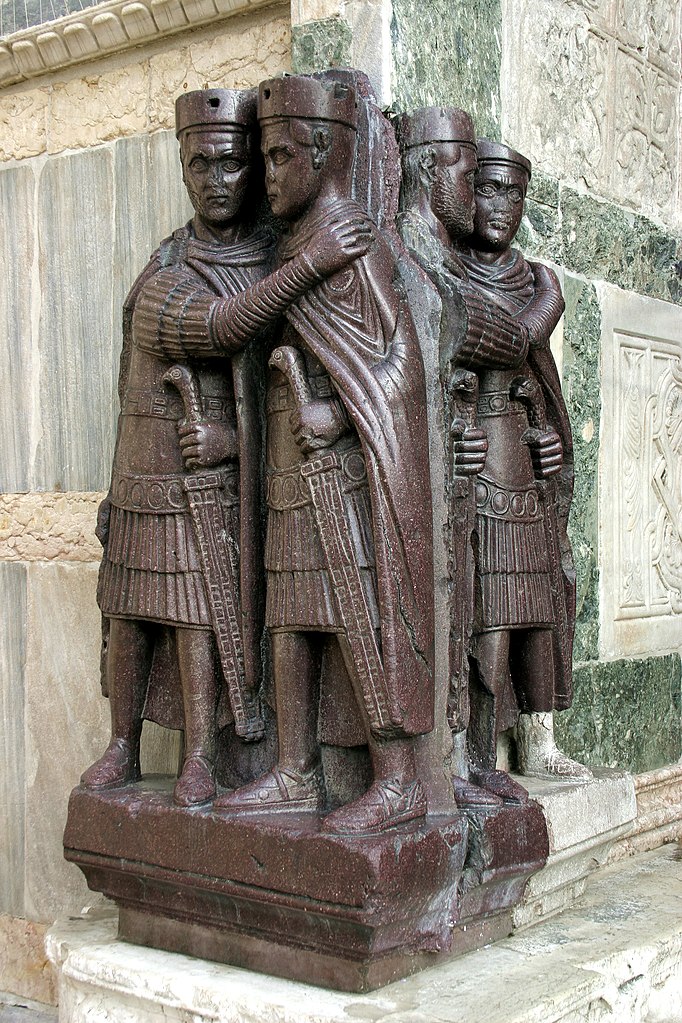
Photograph of The Four Tetrarchs, San Marco Square, Venice, Italy. Photograph by Rudolphous via Wikimedia Commons (CC-BY-SA-2.0).
After the Fall of Rome, the quarry at Mons Porphyrites was abandoned and the use of red porphyry declined significantly in Europe. However, its legacy continued in Byzantine art. During the Byzantine Empire, in keeping with the Roman tradition, red porphyry was incorporated into their regalia and church decorations. Notable examples of this enduring tradition include the red porphyry columns of Hagia Sophia and the Imperial Palace in Constantinople, as well as the commissioned sarcophagi for Byzantine rulers.
During the Middle Ages, the symbolism associated with porphyry evolved to represent Christ in a practice that paralleled the broader symbolism and trends of the period. Craftsmen used this stone to create altars, chalices, and reliquaries, infusing them with deep Christian significance. Imperial porphyry thus became strongly associated with religious themes and found its place in Christian art.
However, with the disappearance of the source of porphyry, its use shifted to the deployment of spolia. The sole reservoir of porphyry in Europe lay within the structures built by the Romans. Consequently, Roman temples were scrapped and repurposed, providing the material for altars, floors, tombs of popes, and more. Notably, the Norman kings of Sicily extensively utilized porphyry and other hard-stone spolia that were imported from Rome, particularly in creating intricate opus sectile mosaics on the floors and walls of Norman churches and palaces.
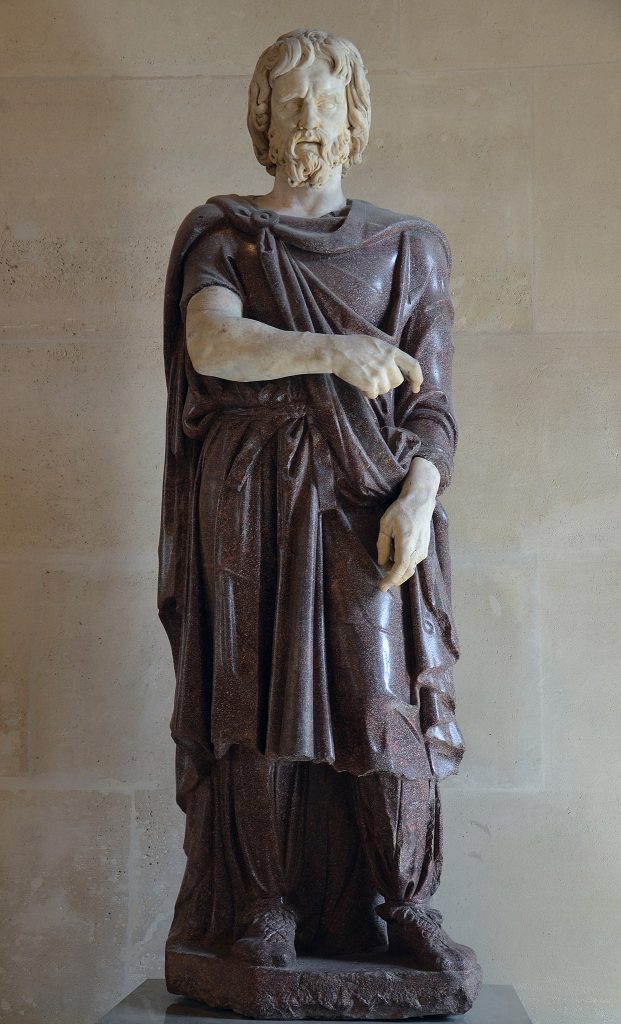
Captive Barbarian in red porphyry and white marble, Louvre Museum, Paris, France. Photograph by Butko via Wikimedia Commons (CC-BY-SA-2.0).
During the Italian Renaissance, a resurgence of interest in classical antiquity led to the rediscovery of the value of the elusive red porphyry. Italian artists and architects of this era sought to capture the grandeur of ancient Rome, making it once again a favored material for columns, tombs, and sculptures.
Alongside this revival, there was also a renewed emphasis on developing techniques to work with this particularly dense stone, as much of the technical expertise had been lost over the centuries. Notably, the Medici family and others like them invested substantial funds and efforts into researching methods for carving porphyry. These included the development of sharper metal tools as wells as solvents capable of softening the stone.
This period witnessed the use of red porphyry in prominent works such as Michelangelo’s tomb of Pope Julius II in the Basilica of San Pietro in Vincoli.
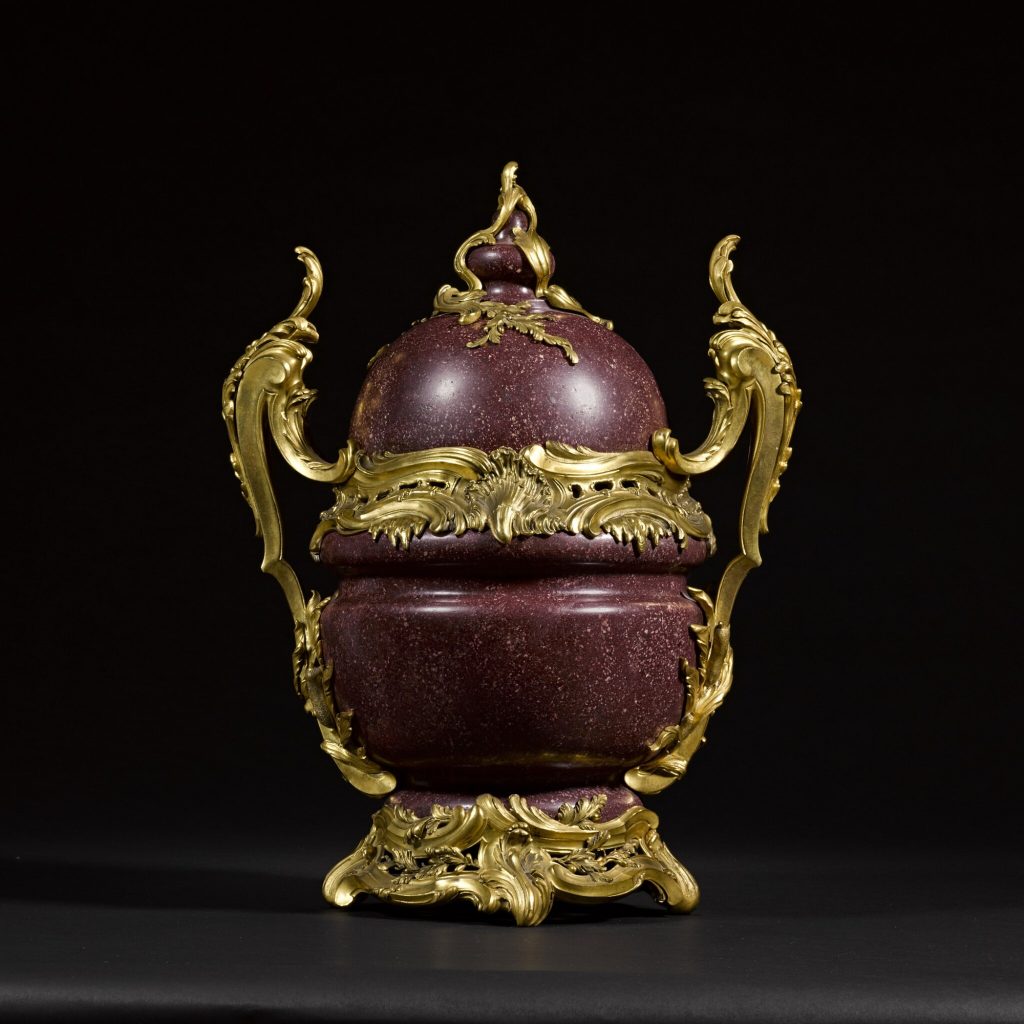
Red porphyry vase with cover with gilt-bronze mounts, ca. 17th and 19th centuries. Sotheby’s.
Beyond Rome, other Italian cities hold noteworthy examples of porphyry, such as Florence, which features a few columns, sculptures, and basins. In Venice, additional examples were obtained through the looting of Constantinople.
Today, the most significant concentration of this stone can still be found in the vicinity of Rome, with the Vatican leading the way by showcasing priceless imperial artifacts. The region in and around Rome boasts a rich collection of porphyry pieces from both the imperial era and later periods, reflecting the enduring interest in this distinctive rock.
DailyArt Magazine needs your support. Every contribution, however big or small, is very valuable for our future. Thanks to it, we will be able to sustain and grow the Magazine. Thank you for your help!